The Huawei Mate S Review
by Andrei Frumusanu on December 2, 2015 8:00 AM EST- Posted in
- Smartphones
- Huawei
- Mobile
- Kirin
- Mate S
Display Measurement
A big part of the story behind the Mate S is the inclusion for the first time Samsung AMOLED screen instead of an traditional LCD panel. Screen quality was in my experience one of the weak-points of Huawei devices. Both the Honor 6 and Mate 7 I reviewed suffered from quite disappointing viewing angles and the P8 review sample I received added in bad backlight bleed into the list of faults with the screens.
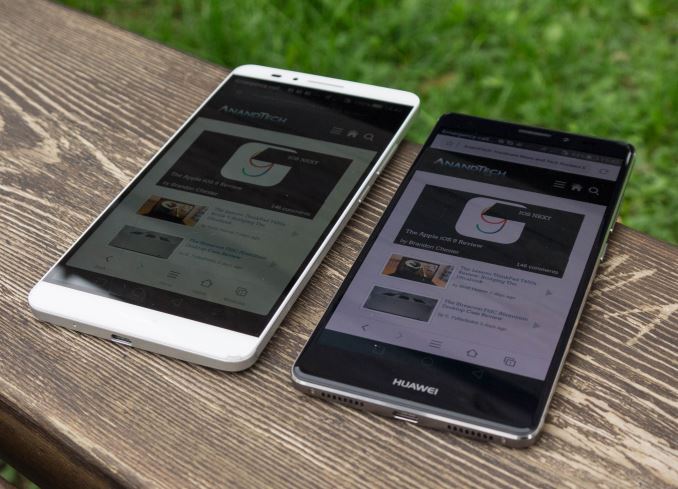
The Mate S is a large departure of Huawei devices of the past as the inclusion of the new AMOLED screen basically eliminates viewing angle issues as well as build quality issues leading to uneven backlight illumination. Huawei also uses a Samsung display driver IC (DDIC) that uses panel-self-refresh, a must in any of today's smartphones.
We start by measuring the maxium brightness of the Mate S. As always, our display testing is done with an X-Rite i1Pro 2 spectrophotometer as our measurement hardware, in conjunction with SpectraCal's CalMAN software suite and our own workflow to be able to get an accurate display characterization.
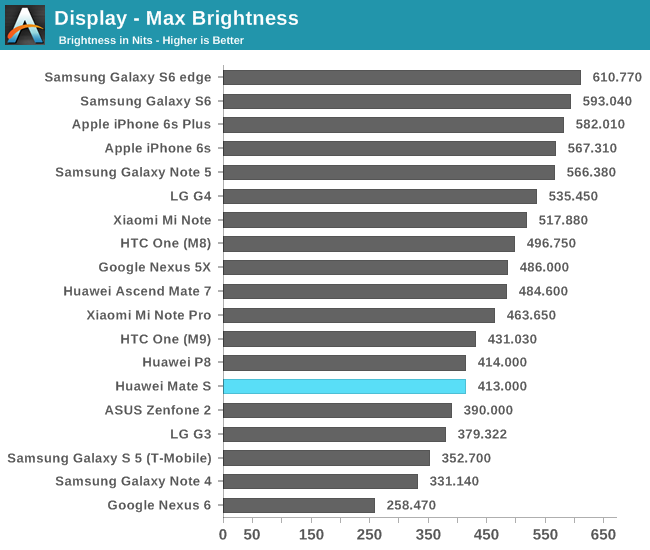
During my intial hands-on with the Mate S I noticed it got quite bright in comparison to usual manual brightness of other AMOLED devices. Indeed, the Mate S is able to go up to 413 cd/m² while traditionally Samsung devices don't exceed 330-350 nits unless you enable auto-brightness in bright lightning conditions. Unfortunately the auto-brightness mode of the Mate S doesn't enable similar boosts so the maximum manual setting on the Mate S is also the maximum the device supports.
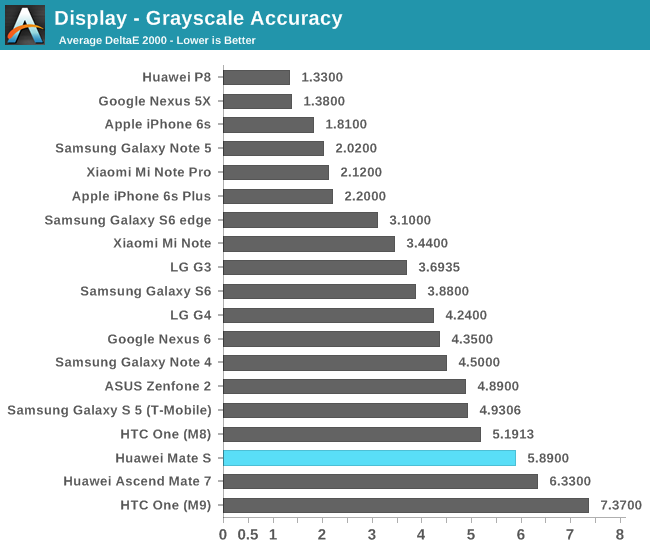
Next, we move to greyscale accuracy testing. Here we see that the Mate S suffers from slight blueish tones as the average colour temperature ends up at 6893K. The dE2000 deviation increases with white value ending up with a total gamma of 2.9 instead of the 2.2 target.
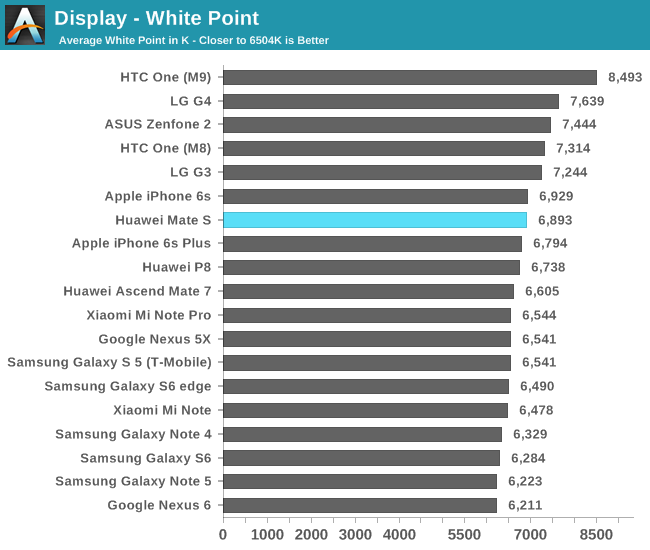
This is rather unfortunate as it had praised the P8's colour accuracy once you set it to minimum colour temperature in the display settings. The Mate S seems to confirm that this was just a one-off coincidence for Huawei as the Mate S's colour temperature slider isn't able to compensate for the bad accuracy results even when I try to hit 6500K with it.
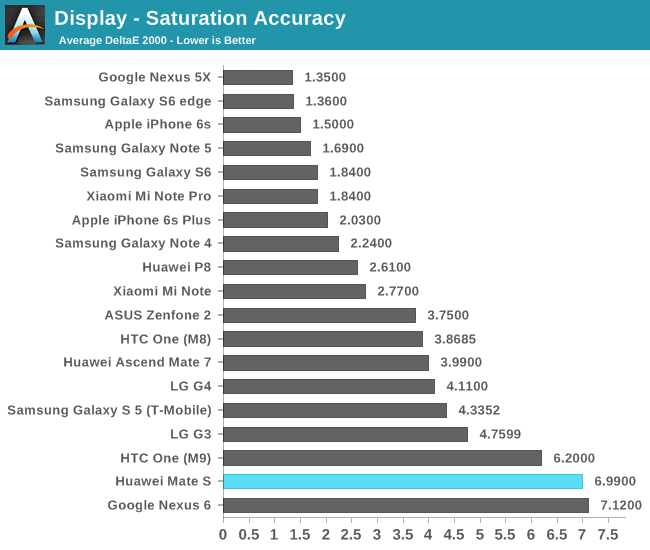
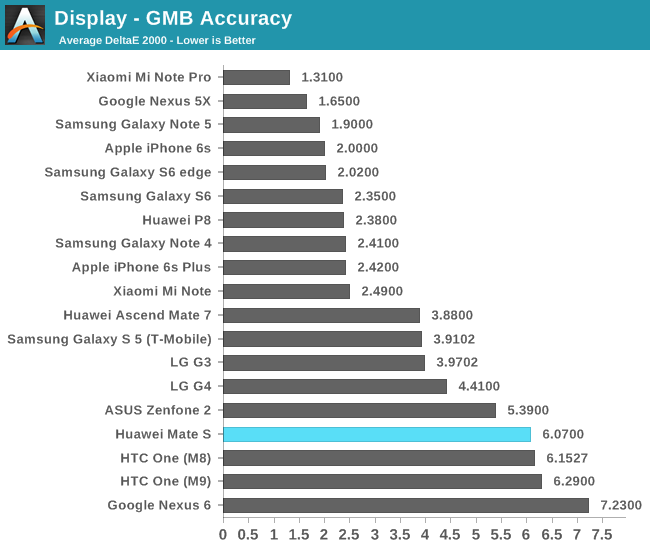
While the Mate S's AMOLED screen represents a large improvement in terms of overall screen quality such as viewing angles and luminance homogenity, it's absolutely not a display that can be considered colour accurate. For people who do not put too much weight into colour accuracy, the vibrant and constrast-rich display might actually be a positive characteristic. In general, the Mate S screen choice does improve over past Huawei devices so it'll definitely be interesting to see how the company will go forward with future devices.
Display Power
We see the Mate S's base power consumption at full black fall in at around 450mW. If accurate, this would fall in around the base power consumption of the Note 4 Exynos. The power here is attributed mostly to various device components such as SoC, DRAM, PMIC and most importantly the DDIC. As the Mate S is only a 1080p device, this is a somewhat disappointing figure but could easily be compensated by an efficient panel.
Unfortuantely, it seems that the Mate S isn't efficient. At 200 cd/m² the Mate S consumes about 769mW of power that can be attributed alone to the increase in luminosity. At maximum brightness, this goes up to 1.75W of screen-power for a total device power of 2.2W. As one can notice in the graph, there's a weird non-linear increase in power for the last measurement point. I investigated this and discovered that at maximum brightness, the screen isn't actually uniformely bright and some parts top off at around ~360 nits while others went to the maximum reached ~410 nits.
| Screen Luminance Power Efficiency 100% APL / White |
||||||
| Device | Screen Luminance Power at 200cd/m² |
Luminance Power (mW) / Screen area (cm²) Efficiency |
||||
| LG G4 | 354 mW | 4.11 | ||||
| Meizu MX4 | 345 mW | 4.14 | ||||
| Huawei P8 | ~341 mW | ~4.43 | ||||
| Meizu MX4 Pro | 386 mW | 4.47 | ||||
| Samsung Galaxy Note 5 | 504 mW | 5.64 | ||||
| Samsung Galaxy S6 | 442 mW | 5.99 | ||||
| Samsung Galaxy S5 | 532 mW | 7.21 | ||||
| Samsung Galaxy Note 4 | 665 mW | 7.22 | ||||
| Samsung Galaxy S5 LTEA | 605 mW | 8.20 | ||||
| LG Flex 2 | 765 mW | 8.89 | ||||
| Samsung Galaxy S4 | 653 mW | 9.22 | ||||
| Huawei Mate S | ~769 mW | ~9.24 | ||||
A few months ago we published a look at AMOLED power efficiency numbers of Samsung Galaxy devices. Since then, I've been able to add in a few more devices to get a better view of overall screen efficiencies. I also decided to present efficiency in mW per cm² of screen area instead of normalizing efficiency values for a certain screen size as I did last time, so this time we have some better concrete values representing real-world physics.
The Mate S falls in extremely close to the efficiency of the Galaxy S4's screen. This is rather unfortunate for a 2015 device as as we can see in the table AMOLED technology has made very large efficiency improvements since then. In fact the Note 5 is currently the most efficienct AMOLED to date and is able to show off a whole 38% better luminance efficiency than the Mate S screen. What is more shocking though is that this represents an over 100% decrease in efficiency when compared to LCD devices such as the P8.
I wish Huawei would have opted for a more efficient AMOLED emitter choice instead what seems to be a cheaper alternative, as this will definitely have an impact on the device's battery life.


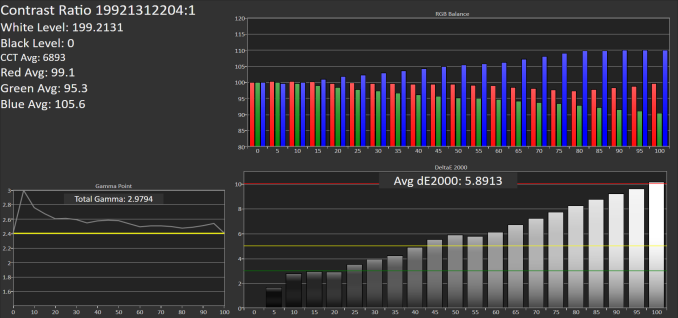

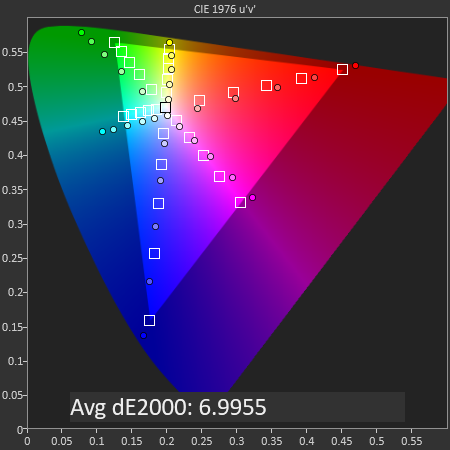


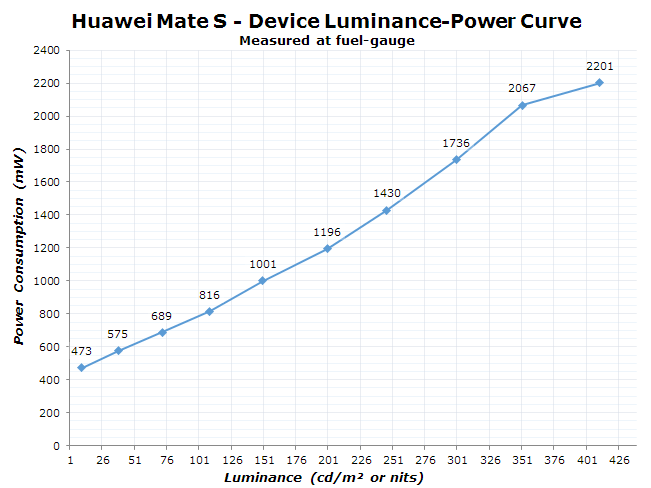








54 Comments
View All Comments
chrone - Wednesday, December 2, 2015 - link
and I thought this is going to be a N6P review we've all been waiting for. 😛Andrei Frumusanu - Wednesday, December 2, 2015 - link
Sorry for the troll but I needed to get this out of the way! The 6P is coming up next as I finish putting it into the CMS over the next few days hopefully.chrone - Wednesday, December 2, 2015 - link
awesome! looking forward to it :Damdwilliam1985 - Thursday, December 3, 2015 - link
thanks in advance, looking forward to it.id4andrei - Thursday, December 3, 2015 - link
Excelenta recenzie domnule Frumusanu. Nu ii asculta pe troli.Piscupescu - Thursday, December 3, 2015 - link
Corect!VnnAmed - Thursday, December 3, 2015 - link
And here I was going crazy because I thought there would be no review of N6P on Anand. Thank Tesla!Ethos Evoss - Wednesday, December 2, 2015 - link
no it won't be because anadatech doesn't want to rwite nice things about huawei :DDDSo they will avoid this phone :DDD
s.yu - Saturday, December 5, 2015 - link
You despicable Huawei drone. I've noticed Huawei doubling down on the trolling and brainwash. There are unbelievable amounts of Huawei ads where I live and brainwash articles of Huawei all over the web.Ethos Evoss - Wednesday, December 9, 2015 - link
ok u iphone drone :D